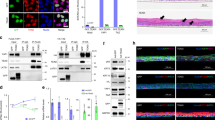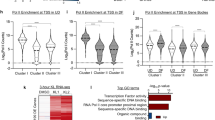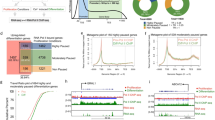Abstract
Since p63-deficient mice display severe defects in formation of epidermis, p63 has been considered to be a multi-isoform p53 family member essential for epidermal development. However, it is still unclear how p63 could contribute to keratinocyte differentiation. In the present study, we have found that TAp63α is induced in association with the upregulation and a secretion of growth differentiation factor 15 (GDF15) during the keratinocyte differentiation of HaCaT cells bearing p53 mutation. Short interference RNA-mediated knockdown of the endogenous TAp63 resulted in a remarkable reduction of GDF15. Luciferase reporter assay and reverse transcription–PCR analysis demonstrated that enforced expression of TAp63α significantly increases the luciferase activity driven by GDF15 promoter and the expression of GDF15. Consistent with these results, the proximal p53/p63-binding site within the GDF15 promoter region was required for the TAp63α-mediated transcriptional activation of GDF15, and TAp63α was recruited onto this site. Furthermore, siRNA-mediated knockdown of the endogenous GDF15 permitted cell growth and inhibited the expression of the differentiation markers such as keratin 10 and involucrin in response to differentiation stimuli. Taken together, our present results provide a novel insight into understanding the molecular mechanisms behind TAp63α-mediated keratinocyte differentiation.
This is a preview of subscription content, access via your institution
Access options
Subscribe to this journal
Receive 50 print issues and online access
$259.00 per year
only $5.18 per issue
Buy this article
- Purchase on Springer Link
- Instant access to full article PDF
Prices may be subject to local taxes which are calculated during checkout







Similar content being viewed by others
References
Agarwal MK, Hastak K, Jackson MW, Breit SN, Stark GR, Agarwal ML . (2006). Macrophage inhibitory cytokine 1 mediates a p53-dependent protective arrest in S phase in response to starvation for DNA precursors. Proc Natl Acad Sci USA 103: 16278–16283.
Ago T, Sadoshima J . (2006). GDF15, a cardioprotective TGF-β superfamily protein. Circ Res 98: 294–297.
Baek SJ, Kim KS, Nixon JB, Wilson LC, Eling TE . (2001). Cyclooxygenase inhibitors regulate the expression of a TGF-β superfamily member that has proapoptotic and antitumorigenic activities. Mol Pharmacol 59: 901–908.
Baek SJ, Wilson LC, Eling TE . (2002). Resveratrol enhances the expression of non-steroidal anti-inflammatory drug-activated gene (NAG-1) by increasing the expression of p53. Carcinogenesis 23: 425–434.
Bauskin AR, Brown DA, Kuffner T, Johnen H, Luo XW, Hunter M et al. (2006). Role of macrophage inhibitory cytokine-1 in tumorigenesis and diagnosis of cancer. Cancer Res 66: 4983–4986.
Bootcov MR, Bauskin AR, Valenzuela SM, Moore AG, Bansal M, He XY et al. (1997). MIC-1, a novel macrophage inhibitory cytokine, is a divergent member of the TGF-β superfamily. Proc Natl Acad Sci USA 94: 11514–11519.
Bottner M, Suter-Crazzolara C, Schober A, Unsicker K . (1999). Expression of a novel member of the TGF-β superfamily, growth/differentiation factor-15/macrophage-inhibiting cytokine-1 (GDF-15/MIC-1) in adult rat tissues. Cell Tissue Res 297: 103–110.
Boukamp P, Petrussevska RT, Breitkreutz D, Hornung J, Markham A, Fusenig NE . (1988). Normal keratinization in a spontaneously immortalized aneuploid human keratinocyte cell line. J Cell Biol 106: 761–771.
Bourdon JC, Fernandes K, Murray-Zmijewski F, Liu G, Diot A, Xirodimas DP et al. (2005). p53 isoforms can regulate p53 transcriptional activity. Genes Dev 19: 2122–2137.
Candi E, Rufini A, Terrinoni A, Dinsdale D, Ranalli M, Paradisi A et al. (2006a). Differential roles of p63 isoforms in epidermal development: selective genetic complementation in p63 null mice. Cell Death Differ 13: 1037–1047.
Candi E, Terrinoni A, Rufini A, Chikh A, Lena AM, Suzuki Y et al. (2006b). p63 is upstream of IKK alpha in epidermal development. J Cell Sci 119: 4617–4622.
De Laurenzi V, Rossi A, Terrinoni A, Barcaroli D, Levrero M, Costanzo A et al. (2000). p63 and p73 transactivate differentiation gene promoters in human keratinocytes. Biochem Biophys Res Commun 273: 342–346.
Hromas R, Hufford M, Sutton J, Xu D, Li Y, Lu L . (1997). PLAB, a novel placental bone morphogenetic protein. Biochim Biophys Acta 1354: 40–44.
Ikawa S, Nakagawara A, Ikawa Y . (1999). p53 family genes: structural comparison, expression and mutation. Cell Death Differ 6: 1154–1161.
Kaghad M, Bonnet H, Yang A, Creancier L, Biscan JC, Valent A et al. (1997). Monoallelically expressed gene related to p53 at 1p36, a region frequently deleted in neuroblastoma and other human cancers. Cell 90: 809–819.
King KE, Ponnamperuma RM, Gerdes MJ, Tokino T, Yamashita T, Baker CC et al. (2006). Unique domain functions of p63 isotypes that differentially regulate distinct aspects of epidermal homeostasis. Carcinogenesis 27: 53–63.
Koster MI, Dai D, Roop DR . (2007). Conflicting roles for p63 in skin development and carcinogenesis. Cell Cycle 6: 269–273.
Koster MI, Kim S, Huang J, Williams T, Roop DR . (2006). TAp63α induces AP-2γ as an early event in epidermal morphogenesis. Dev Biol 289: 253–261.
Koster MI, Kim S, Mills AA, DeMayo FJ, Roop DR . (2004). p63 is the molecular switch for initiation of an epithelial stratification program. Genes Dev 18: 126–131.
Lambert JR, Kelly JA, Shim M, Huffer WE, Nordeen SK, Baek SJ et al. (2006). Prostate derived factor in human prostate cancer cells: gene induction by vitamin D via a p53-dependent mechanism and inhibition of prostate cancer cell growth. J Cell Physiol 208: 566–574.
Lapi E, Iovino A, Fontemaggi G, Soliera AR, Iacovelli S, Sacchi A et al. (2006). S100A2 gene is a direct transcriptional target of p53 homologues during keratinocyte differentiation. Oncogene 25: 3628–3637.
Lehman TA, Modali R, Boukamp P, Stanek J, Bennett WP, Welsh JA et al. (1993). p53 mutations in human immortalized epithelial cell lines. Carcinogenesis 14: 833–839.
Li PX, Wong J, Ayed A, Ngo D, Brade AM, Arrowsmith C et al. (2000). Placental transforming growth factor-beta is a downstream mediator of the growth arrest and apoptotic response of tumor cells to DNA damage and p53 overexpression. J Biol Chem 275: 20127–20135.
Mills AA, Zheng B, Wang XJ, Vogel H, Roop DR, Bradley A . (1999). p63 is a p53 homologue required for limb and epidermal morphogenesis. Nature 398: 708–713.
Nazarova N, Qiao S, Golovko O, Lou YR, Tuohimaa P . (2004). Calcitriol-induced prostate-derived factor: autocrine control of prostate cancer cell growth. Int J Cancer 112: 951–958.
Osada M, Park HL, Nagakawa Y, Yamashita K, Fomenkov A, Kim MS et al. (2005). Differential recognition of response elements determines target gene specificity for p53 and p63. Mol Cell Biol 25: 6077–6089.
Osada M, Park HL, Park MJ, Liu JW, Wu G, Trink B et al. (2007). A p53-type response element in the GDF15 promoter confers high specificity for p53 activation. Biochem Biophys Res Commun 354: 913–918.
Paralkar VM, Vail AL, Grasser WA, Brown TA, Xu H, Vukicevic S et al. (1998). Cloning and characterization of a novel member of the transforming growth factor-β/bone morphogenetic protein family. J Biol Chem 273: 13760–13767.
Roninson IB . (2003). Tumor cell senescence in cancer treatment. Cancer Res 63: 2705–2715.
Tan M, Wang Y, Guan K, Sun Y . (2000). PTGF-β, a type β transforming growth factor (TGF-β) superfamily member, is a p53 target gene that inhibits tumor cell growth via TGF-β signaling pathway. Proc Natl Acad Sci USA 97: 109–114.
Uchida K, Chaudhary LR, Sugimura Y, Adkisson HD, Hruska KA . (2003). Proprotein convertases regulate activity of prostate epithelial cell differentiation markers and are modulated in human prostate cancer cells. J Cell Biochem 88: 394–399.
Yang A, Kaghad M, Wang Y, Gillett E, Fleming MD, Dotsch V et al. (1998). p63, a p53 homolog at 3q27–29, encodes multiple products with transactivating, death-inducing, and dominant-negative activities. Mol Cell 2: 305–316.
Yang A, McKeon F . (2000). p63 and p73: p53 mimics, menaces and more. Nat Rev Mol Cell Biol 1: 199–207.
Yang A, Schweitzer R, Sun D, Kaghad M, Walker N, Bronson RT et al. (1999). p63 is essential for regenerative proliferation in limb, craniofacial and epithelial development. Nature 398: 714–718.
Yang A, Walker N, Bronson R, Kaghad M, Oosterwegel M, Bonnin J et al. (2000). p73-deficient mice have neurological, pheromonal and inflammatory defects but lack spontaneous tumours. Nature 404: 99–103.
Acknowledgements
We are grateful to Dr G Melino for providing TAp63α and ΔNp63α expression plasmids. We also thank Ms Y Nakamura for technical assistance. This work was supported in part by a grant-in-aid from the Ministry of Health, Labour and Welfare for Third Term Comprehensive Control Research for Cancer, a grant-in-aid for Scientific Research on Priority Areas from the Ministry of Education, Culture, Sports, Science and Technology, Japan, a grant-in-aid for Scientific Research from Japan Society for the Promotion of Science, Uehara Memorial Foundation and Hisamitsu Pharmaceutical Co.
Author information
Authors and Affiliations
Corresponding author
Rights and permissions
About this article
Cite this article
Ichikawa, T., Suenaga, Y., Koda, T. et al. TAp63-dependent induction of growth differentiation factor 15 (GDF15) plays a critical role in the regulation of keratinocyte differentiation. Oncogene 27, 409–420 (2008). https://doi.org/10.1038/sj.onc.1210658
Received:
Revised:
Accepted:
Published:
Issue Date:
DOI: https://doi.org/10.1038/sj.onc.1210658
Keywords
This article is cited by
-
p63 is a cereblon substrate involved in thalidomide teratogenicity
Nature Chemical Biology (2019)
-
A global analysis of the complex landscape of isoforms and regulatory networks of p63 in human cells and tissues
BMC Genomics (2015)
-
Wilms’ tumor gene 1 regulates p63 and promotes cell proliferation in squamous cell carcinoma of the head and neck
BMC Cancer (2015)
-
Growth/differentiation factor-15 and its role in peripheral nervous system lesion and regeneration
Cell and Tissue Research (2015)
-
Calumenin-15 facilitates filopodia formation by promoting TGF-β superfamily cytokine GDF-15 transcription
Cell Death & Disease (2013)



